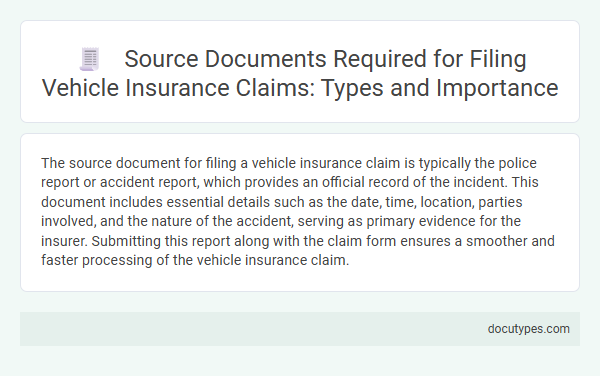The source document for filing a vehicle insurance claim is typically the police report or accident report, which provides an official record of the incident. This document includes essential details such as the date, time, location, parties involved, and the nature of the accident, serving as primary evidence for the insurer. Submitting this report along with the claim form ensures a smoother and faster processing of the vehicle insurance claim.
Introduction to Source Documents for Vehicle Insurance Claims
Source documents are essential for filing a vehicle insurance claim. They provide the necessary evidence to support the claim and ensure a smooth processing experience.
These documents typically include the police report, vehicle registration, and proof of insurance. Photographs of the damage and repair estimates also serve as critical supporting materials. Having accurate and complete source documents helps expedite the claim verification and approval process.
Importance of Accurate Documentation in Insurance Filing
The source document for filing a vehicle insurance claim is typically the accident report or police report. This document provides verified details about the incident, serving as a critical foundation for the claim process.
Accurate documentation ensures that insurance companies can assess the claim fairly and quickly. Proper records reduce the risk of claim denial and help expedite damage assessment and compensation.
Common Types of Source Documents Needed
| Source Document | Description | Purpose in Vehicle Insurance Claim |
|---|---|---|
| Police Report | Official documentation filed by law enforcement after an accident. | Provides an unbiased account of the incident and verifies that a collision or damage occurred. |
| Accident Report Form | Form completed by the insured detailing the circumstances of the accident. | Offers the insurer necessary details including date, time, location, and conditions. |
| Vehicle Registration Certificate | Legal document proving vehicle ownership and registration details. | Confirms the insured vehicle's identity and ownership for claim processing. |
| Insurance Policy Document | Contract outlining coverage terms, limits, and claimant's details. | Verifies policy validity and applicable coverage for the claim. |
| Repair Estimates or Bills | Quotes or invoices from authorized repair shops regarding vehicle damage. | Documents the extent and cost of repairs needed after the incident. |
| Medical Reports | Records from healthcare providers if injuries arise from the accident. | Supports claims relating to bodily injury coverage. |
| Photographs of Vehicle Damage | Images capturing the damage sustained by the vehicle during the incident. | Serves as visual evidence to support the claim and assess damage severity. |
Vehicle Registration Certificate (RC)
The Vehicle Registration Certificate (RC) is the primary source document required for filing a vehicle insurance claim. It contains essential details about the vehicle that are necessary for processing the claim swiftly.
- Identification Proof - The RC verifies the legal ownership and registration details of the vehicle involved in the claim.
- Vehicle Details - It includes critical information such as the engine number, chassis number, and make/model of the vehicle.
- Claim Processing - Presenting the RC helps insurers confirm vehicle authenticity and accelerates claim approval procedures.
Insurance Policy Document
The primary source document for filing a vehicle insurance claim is your insurance policy document. This document contains all necessary details to support the claim process effectively.
- Insurance Policy Number - Identifies your specific coverage and is required to initiate the claim.
- Coverage Details - Lists protections and limits, helping assess claim eligibility and scope.
- Policyholder Information - Verifies your identity and contact information for claim communication.
Driver’s License Requirements
The source document for filing a vehicle insurance claim often includes the driver's license as a critical requirement. This document verifies the identity and driving authorization of the individual involved in the incident.
- Valid Driver's License - Insurance companies require a current and valid driver's license to process a vehicle claim efficiently.
- Identification Verification - The driver's license serves as proof of personal identity, linking the claimant to the vehicle and accident details.
- Compliance with Policy Terms - Providing a driver's license ensures adherence to the insurance policy's conditions regarding responsible driving status.
Submit a clear copy of your driver's license as part of your vehicle insurance claim documentation to avoid delays.
First Information Report (FIR) or Police Report
What is the source document required for filing a vehicle insurance claim? The primary source document for a vehicle insurance claim is the First Information Report (FIR), also known as the Police Report. This document provides an official account of the incident, helping to verify the details of the accident and enabling the insurance company to process the claim efficiently.
Repair Estimates and Bills
The source document for filing a vehicle insurance claim primarily includes repair estimates and bills. Repair estimates provide a detailed assessment of the damage and the projected cost to fix the vehicle. Bills or invoices from the repair shop verify the actual expenses incurred during the repair process, supporting the claim submission.
Photographic Evidence and Accident Site Photos
The primary source document for filing a vehicle insurance claim is photographic evidence capturing the accident details. Photos of the accident site provide clear, objective proof of damages and vehicle positions. These images support the claim by verifying the extent of the incident and assisting in the accurate assessment of liability and repair costs.
What Is the Source Document for Filing a Vehicle Insurance Claim? Infographic

